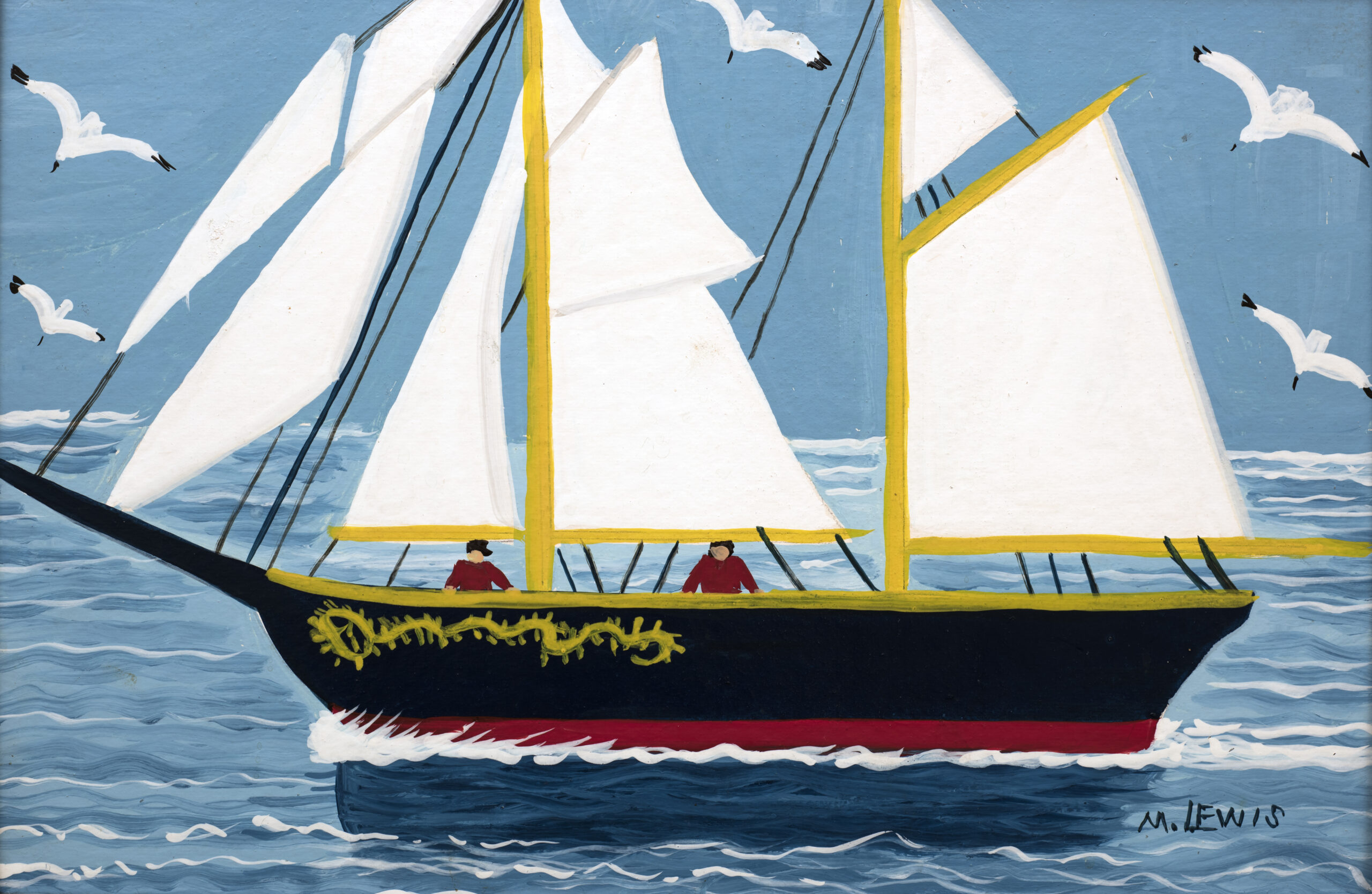MAUD LEWIS’S BLUENOSE

Could there possibly be a more Nova Scotian painting than Maud Lewis’s Bluenose? The obvious answer is “No”. It would have to be a painting of a bagpipe-playing lobster by Anne Murray to top Nova Scotia icon Maud Lewis’s painting of the iconic Bluenose schooner.
Maud Lewis had a repertoire of subjects she returned to often, like big-eyed cats, yoked oxen or Cape Islander boats. These were images from the world she experienced living in South-Western Nova Scotia. The Bluenose was not a subject she was known for revisiting. The Bluenose was certainly well known when she made this painting in the 1960s but she probably wasn’t painting the International Fisherman’s Cup winning boat launched in 1921. In the early 1960s, the Oland family commissioned a copy of Bluenose to be built as a pleasure yacht and marketing tool for their Schooner Lager. That boat, the one Maud painted, was the Bluenose II. In the chaos of World War II the original Bluenosewas sold, shorn of sails and sank off the coast of Haiti in 1946. This was an ignominious end for such a celebrated craft. Grand Banks schooners like the Bluenose were built for both fishing and racing. A fast boat could deliver fish to shore quickly. Being fastest was a marketable advantage and after fishing season came racing season. Within ten years of being built, the Bluenose and schooners of its type were being replaced by faster motorized ships. Throughout the 1930s the famous Bluenose raced and travelled as an ambassador of Nova Scotia until the war broke out in 1939.
Since 1937, the Canadian dime has had an image of a Grand Banks schooner that was in fact a composite image of the Bluenose and two other boats. It has always been referred to as the Bluenose and in 2002, the government finally declared that it is.
Maud Lewis rarely travelled any distance beyond Yarmouth and Digby counties. There is a good chance she never saw the Bluenose or Bluenose II other than in pictures. When she painted boats, it was usually sail boats or Cape Islanders in Digby Harbour. Her Bluenose has two sailors resting their arms on the gunwales of the speeding vessel. They would be giants if they were painted to actual scale. By the 1960s, the arthritis in Maud’s hands limited the level of detail in her paintings. She painted people on the boat because it was on the water, under full sail and moving fast. It made for a better picture too.
‘Bluenoser’ is a nickname for Nova Scotian settlers that dates to the 1700s. No one knows exactly how it arose but it’s clearly one of those nicknames that was originally unflattering and eventually worn as a source of pride. One theory has the blue dye of fisher’s mittens turning their noses blue as they wiped them. The implication of Bluenoser is that it is cold and the people of Nova Scotia are hearty. Maud Lewis lived like a ‘Bluenoser’ until her death in 1970. Her heat came from burning wood and her light came from oil lamp. She was a tenacious spirit in the face of life’s adversities.
Her house has a parallel with the story of the original Bluenose but with a different outcome. Maud Lewis achieved renown during her lifetime and her painted house was a celebrated destination for visitors to Digby County. After her death and her husband Everett’s, the painted house fell into disrepair and came exceedingly close to being lost forever like the Bluenose. The efforts of many Bluenosers who recognized its value ensured that it would be preserved for future generations to enjoy. It is now owned by the people of Nova Scotia as is the Bluenose II which was sold to the province in 1970 for the price of ten dimes.

